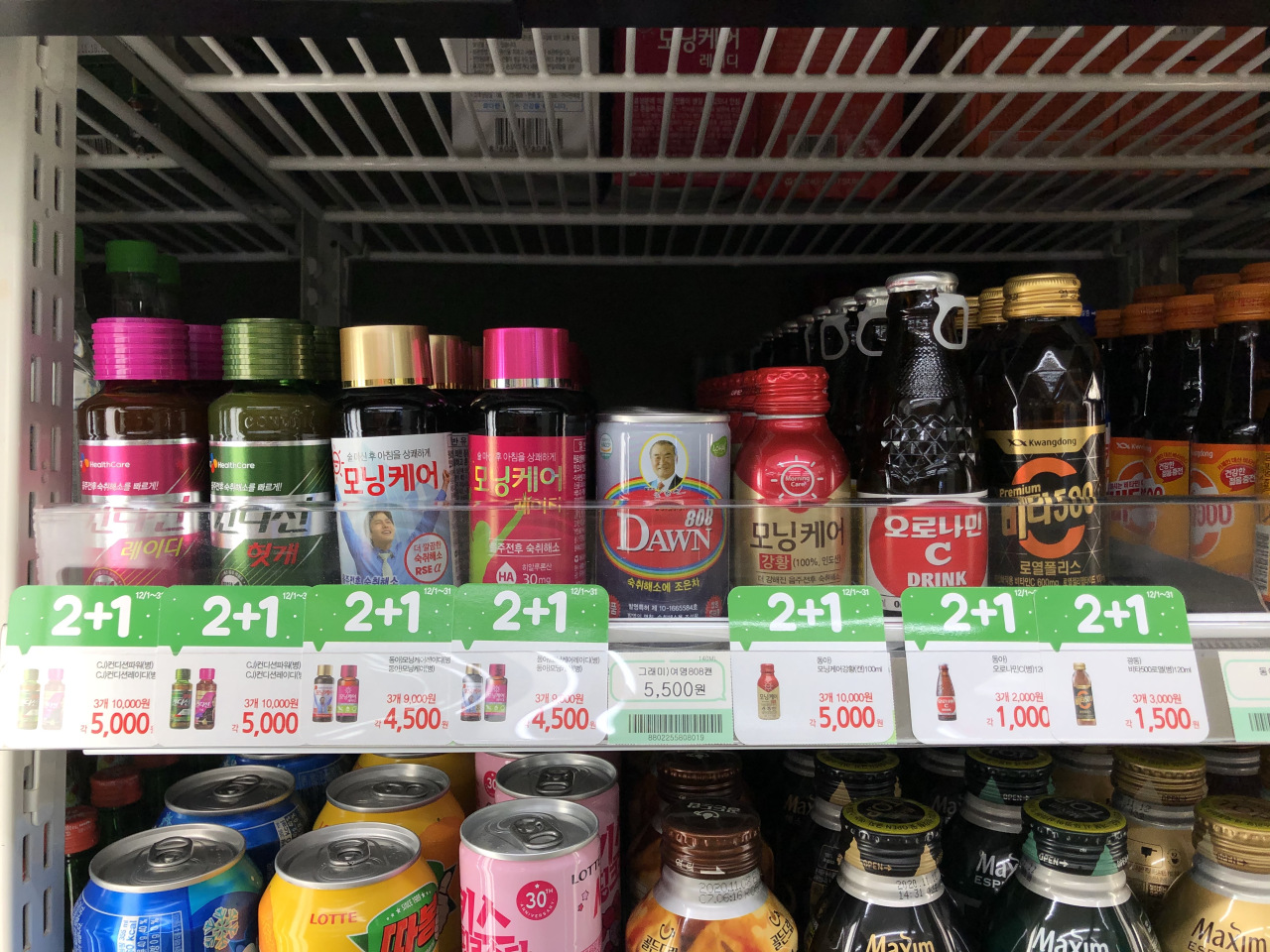Given the average amount of alcohol Koreans consume on a daily basis, it is no wonder the hangover cure market here has been continuously growing at an annual 15 percent.
The demand for these cures is especially strong around the end-of-year season during which time Koreans spend night after night socializing one last time before the year ends.
But the truth is the exact mechanism to erase a hangover is not scientifically identified as of yet, and the hangover cures out in the market are merely beverages containing natural extracts believed to help alleviate pain, but are not certified drugs or supplements.
“The hangover cures found in convenience stores are not drugs. They are functional food,” said Lee Kwang-min, spokesperson for Korean Pharmaceutical Association.
“One might as well stick to the conventional hangover foods like soups, or better yet, not drink so much. But that is up to the person,” said Lee.
The hangover potion that dominates the market in Korea is CJ HealthCare’s Condition. Launched in 1992, the oldest Korean hangover potion had 49 percent of the market share in the first half of 2019.
The second bestselling is Glami’s Dawn series, followed by Dong-A Pharmaceutical’s Morning Care.
These potions are exported -- Condition is sold in China, Japan and Vietnam; Dawn is sold in the US, China, Japan, Singapore, Indonesia, Vietnam, Philippines, Dubai, Malaysia, Ghana, Australia and New Zealand; and Morning Care is sold in Russia.
Among imported cures, the vitamin supplement RU-21, invented in Russia, is a popularly recommended tablet here that is believed to boost one’s alcoholysis capabilities.
According to market ranking service Nielsen Korea, the hangover relief market in 2015 was 135.2 billion won ($116.6 million), and is expected to cross the 250 billion mark in 2019.
Starting 2018, the other-form products in the shape of small globuletes, jelly and squeezables, logged 40.3 billion won and rising.
Driving the change is Samyang’s Easy Tomorrow globuletes that are reportedly appealing to the younger generation for portability convenience.
Handok’s ReadyQ Chu jellies also shot up in sales after a Chinese internet influencer Wanghong introduced it as a must-buy item in Korea. ReadyQ now exports to China.
More players are jumping in to have a slice of the hangover cure market pie. Yuhan, one of the oldest pharmaceuticals company in Korea, has launched a potion using dendropanax tree extracts mixed with honey. Chong Kun Dang, represented by their Korean ginseng products, is preparing a hangover solution using baked silkworms.
These hangover drinks are priced at 4,500 won ($3.8) each to as much as 10,000 won for the especially strengthened potions. Those targeting lady drinkers try to standout by saying they contain hyaluronic acid for skin rejuvenating effects.
While hangover cures may provide some immediate relief, their contents are simply a mixture of glucose with natural ingredients such as oriental raisin tree, the alder tree extracts, aspartic acid and curcumin. Their effects are similar to that of normal food.
“They do contain substances that may help rid hangover to some degree, but their effects are not as great as to be classified as drugs,” said Lee from the pharmaceuticals association.
The potions legally carry the label “hangover cure,” after the Constitutional Court’s acknowledgement in 1999 of company Glami’s commercial expression rights to promote its alder tree herbal tea Dawn 808 as a hangover solution. The Ministry of Food and Drug Safety, which had earlier protested the labeling, has shied away from the issue since.
“You know how there are countries where the drinking culture is strong. The more citizens drink, the more developed and diversified is the country’s hangover curing methods,” Lee said.
Euromonitor statistics in 2014 credited Korea as the No. 1 country for hard liquor consumption.
Alcoholic beverage company Hite Jinro sells 150 million bottles of its Chamisul soju every month. To put that figure in perspective, in 2018, the national statistics institute counted there were 37 million people in Korea aged between the active drinking age of 20 and 70. This means on average, Koreans drink 4.8 bottles of HiteJinro soju a month.
Chungnam National University Hospital in Dajeon published a study in August, advising to cap the alcohol consumption at eight glasses per week for men, and four glasses per week for women. Women inherently have less alcohol dehydrogenase, the enzyme that breaks down the acetaldehyde.
Hangover happens when alcohol breaks down in to acetaldehyde inside human body. It is the acetaldehyde that produces lingering headaches, and heartburn and nausea due to increased stomach acid secretion.
It goes without saying, it is bad for the body to overdrink, but worse to drink every day even in small amounts, according to health care experts. The liver needs time off to rest and recover in its function as the body’s purification tower.
Regardless of the health warnings, drinkers tend to stick to their own hangover regimen.
Some go for a cardio session the day after drinking to let out the toxins through perspiration. Some others resort to a creative recipe of drugs to tackle the hangover heartburns.
As for headache, drinking lots of water and eating carbohydrate-based food is a way. Taking painkillers is not advised, as this would increase the toxicity level the liver has to handle.
By Lim Jeong-yeo (
kaylalim@heraldcorp.com)








